Mathias Kruines, ca. 1770 - 1811
Marie-Madeleine Deffer Kruines, ca. 1770 - ca. 1829
Marie-François-Antoine Kruines, 1799 - 1866
by Brian Stevenson
last updated February, 2021
The Kruines family of Paris produced well-regarded microscopes and other scientific, engineering, and optical apparatus. Father Mathias established the business in 1800 on Quai de l’Horloge, Paris. This was a popular site for such businesses; although he faced stiff competition from numerous makers of high-quality goods, the concentration of optical and scientific businesses probably made Quai de l’Horloge a prime destination for buyers of such devices.
The address number changed over the years, from the initial number 42 to number 61 during 1805, then to number 21 ca. 1850. Those changes were probably due to renumbering of the street, rather than physical moves of the shop. These addresses may prove useful in dating Kruines instruments.
Mathias’ widow, Marie-Madeleine, ran the business after his death. In 1829, the Almanach du Commerce de Paris listed the owner as “Kruines fils” (i.e. son Marie-François-Antoine). After his death in 1866, the business was acquired by Eulalie and Marius Rambaud, who operated the business as Kruines-Rambaud. A neighbor, Sévère Boissel, purchased the stock of Kruines-Rambaud in 1873, and subsequently advertised himself as successor to Kruines and Rambaud.
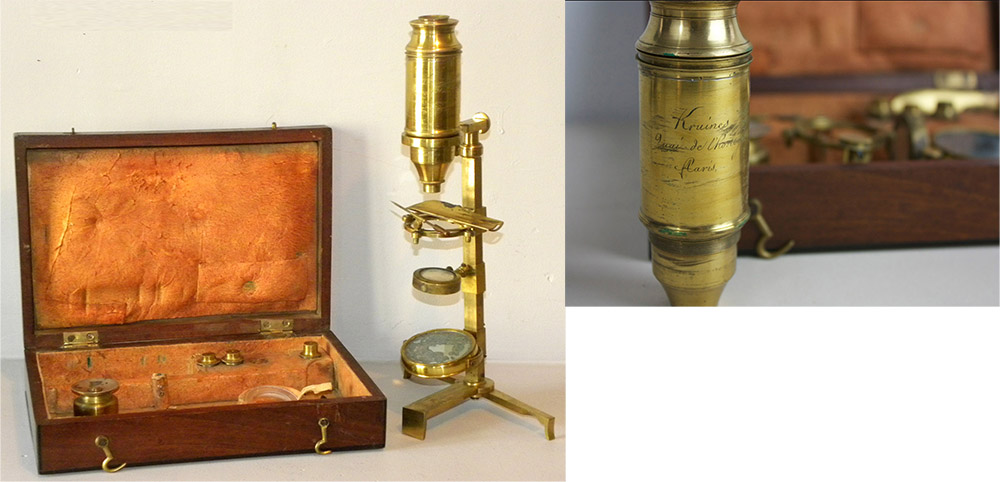
Figure 1.
A ca. 1830s microscope signed “Kruines, Quai de l’Horloge, Paris”. It is based on the pattern of Louis François Dellebarre (1726-1805), as are many other early microscopes that are signed by Marie-François Kruines or attributable to him. The cabinet shown with this instrument is probably not original. Adapted for nonprofit, educational purposes from an internet sale site.
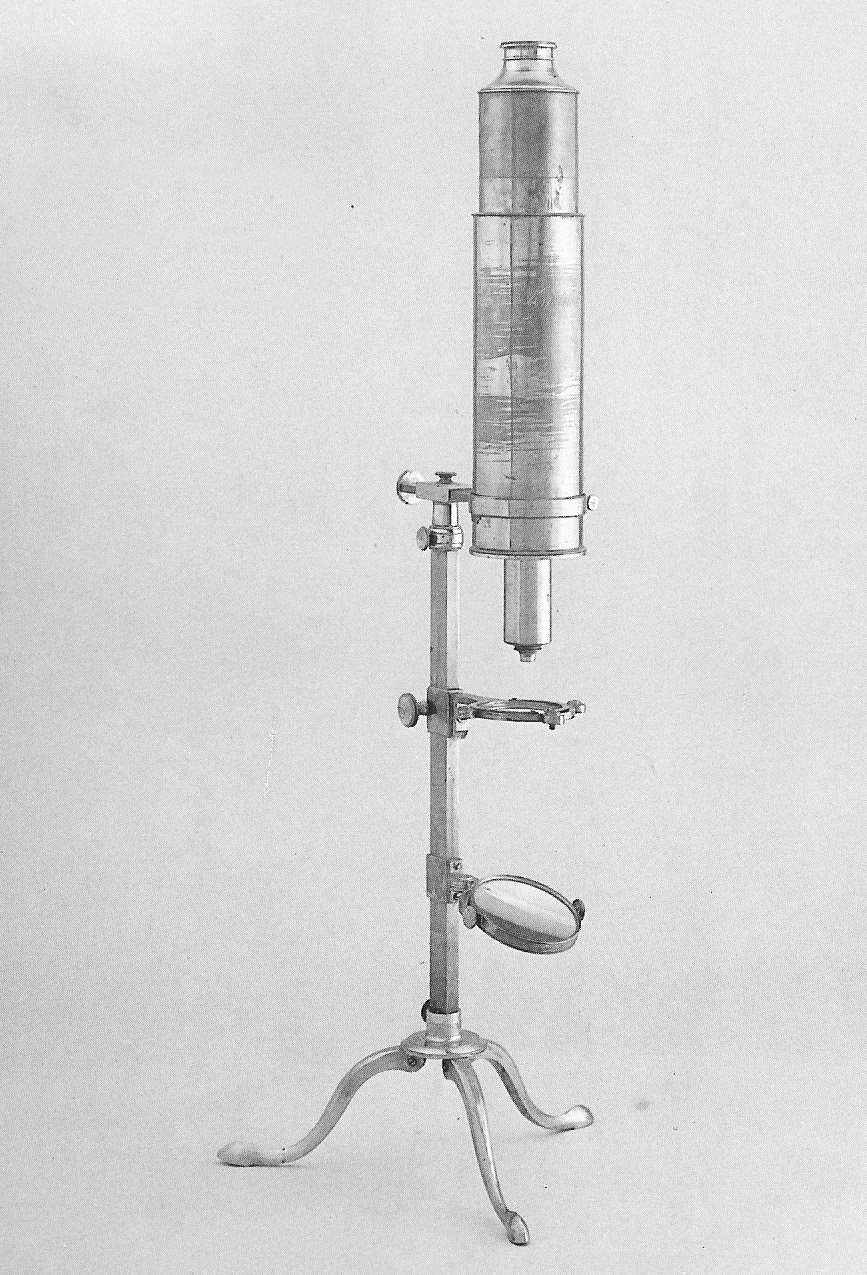
Figure 2.
Another ca. 1830s Dellebarre-type microscope, signed “Kruines” on the body tube. A similar (possibly the same) microscope was described in "Collection Nachet", instrument 78. Image adapted for nonprofit, educational purposes from H.P. Nowak "Geschichte des Mikroskops".
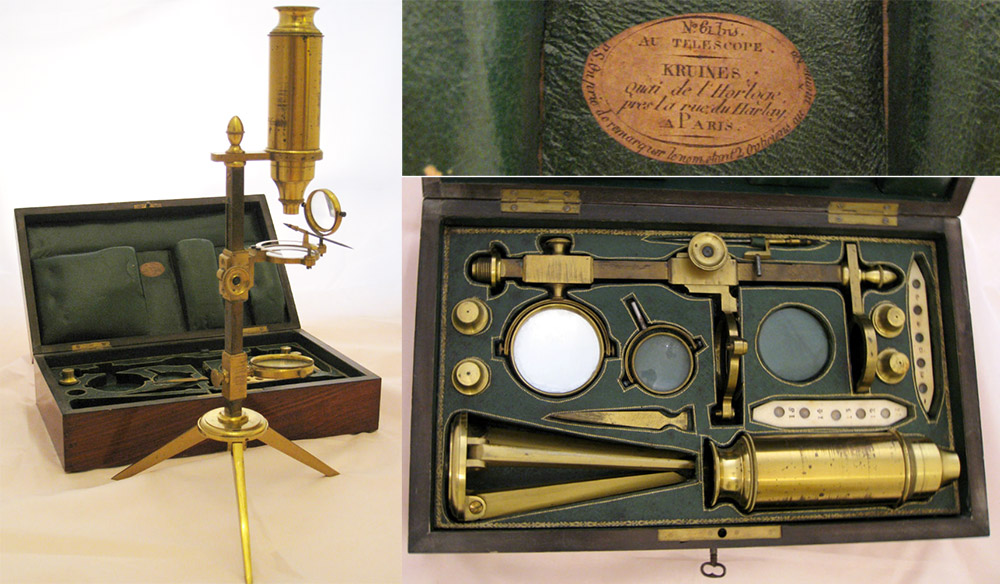
Figure 3.
A ca. 1830s microscope with Kruines’ trade label glued inside the lid. The similarities between this and the microscopes shown in Figures 1 and 3 suggest that Kruines was the actual maker. The case, with form-fitting spaces for all components and metallic lace trim, is undoubtedly original. Adapted for nonprofit, educational purposes from an internet sale site.
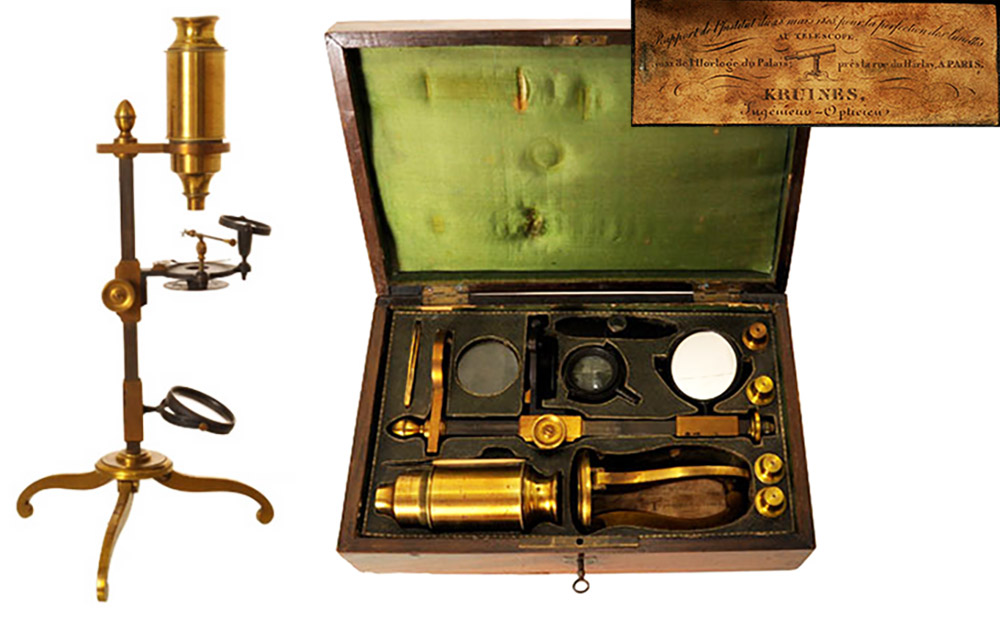
Figure 4.
This microscope is virtually identical to that shown in Figure 3, except for the foot. This also has Kruines’ trade label glued inside the case. An identical microscope, unsigned, is shown in "Collection Nachet", Plate XIII, instrument 64. Images adapted for nonprofit, educational purposes from an internet sale site.
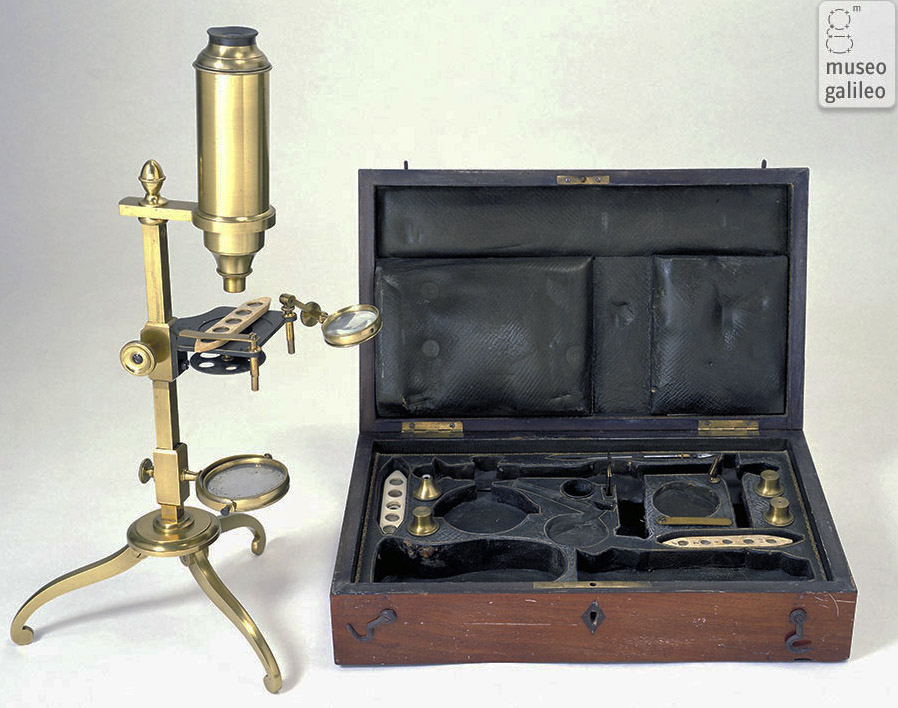
Figure 5.
An unsigned microscope that is identical to the Kruines instrument that is shown in Figure 3. Another, identical microscope, also unsigned, is shown in "Collection Nachet", Plate XIII, instrument 64. Images adapted for nonprofit, educational purposes from https://catalogue.museogalileo.it/object/CompoundMicroscope_n06.html.

Figure 6.
Two additional microscopes that are essentially identical to the Kruines instruments that are shown in Figures 2 and 3, with the exception of the feet. The microscope on the left is signed on the foot “Pixii á Paris”, and that on the right is signed “Ripamonti á Bordeaux”. Although Nicholas Pixii is known to have made microscopes at the time that he took over the Domotiez business in 1819, he and his son soon turned their attentions to manufacturing instruments for examining physical phenomena. Later Pixii catalogues included a few microscopes, but these were probably brought in from wholesale manufacturers. The Ripamonti family were makers of barometers, compasses, and other nautical apparatus, but were not known to have made microscopes. Considering those facts, it is likely that both of these microscopes were made by Kruines for wholesale distribution, and retailed by Pixii and Ripamonti. Images adapted for nonprofit, educational purposes from internet sale sites.
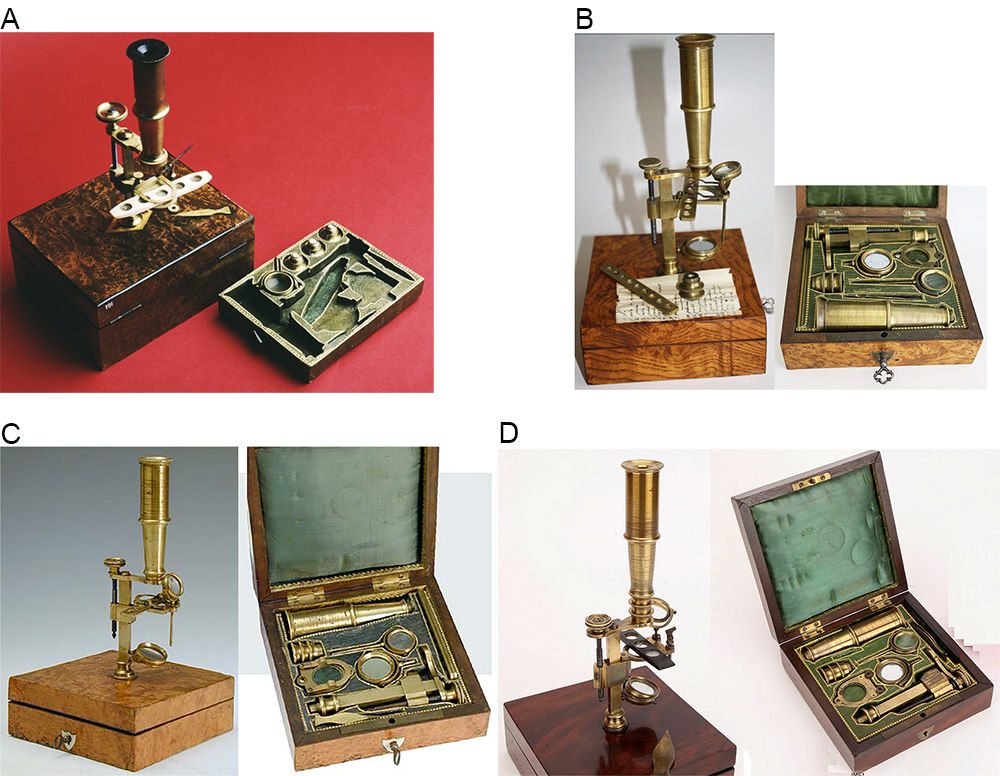
Figure 7.
Four ca. 1830-40 microscopes, all of the same design. A, from The Whipple Museum, is signed "Kruines Freres, Quai de l'Horloge a Paris". Considering that instrument, and comparing the style of these cabinets with those shown in Figures 3-6, suggests that all of these microscopes were manufactured by Kruines. Adapted for nonprofit, educational purposes from https://collections.whipplemuseum.cam.ac.uk/objects/11747 and internet auction/retail sites.
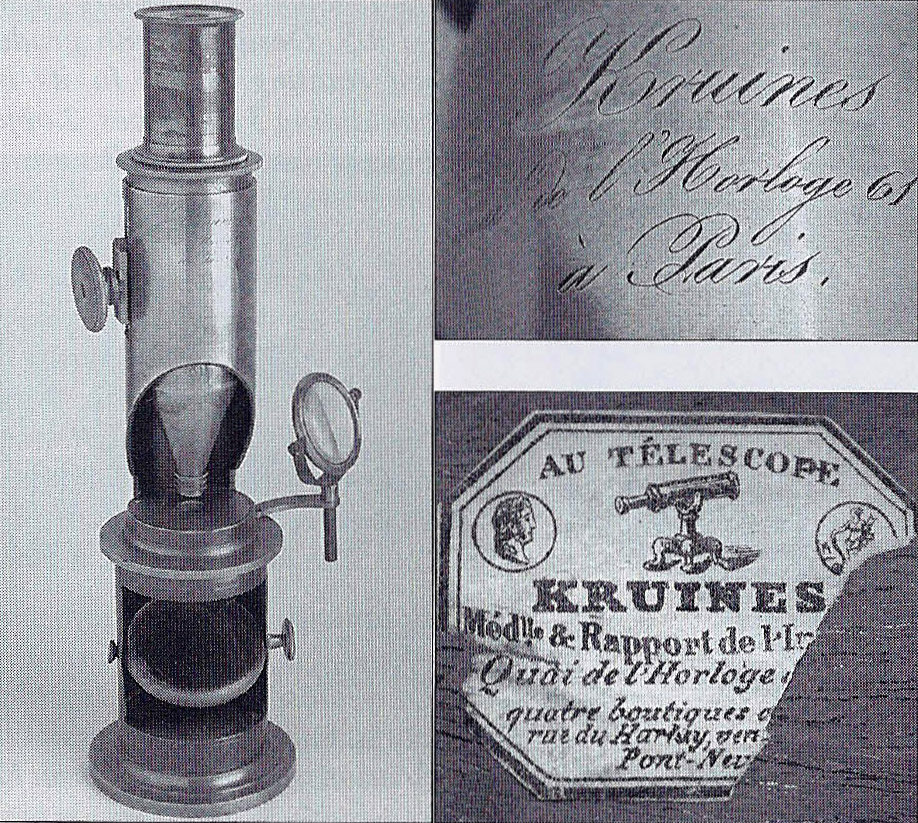
Figure 8.
A drum microscope, signed "Kruines, Quai de l'Horloge 61, Paris". That address indicates production between 1805 and ca. 1850. The microscope case also bears a paper label from Kruines. The family's shop advertised with the sign of a telescope, hence "au Telescope". Images adapted for nonprofit, educational purposes from an internet sale site.
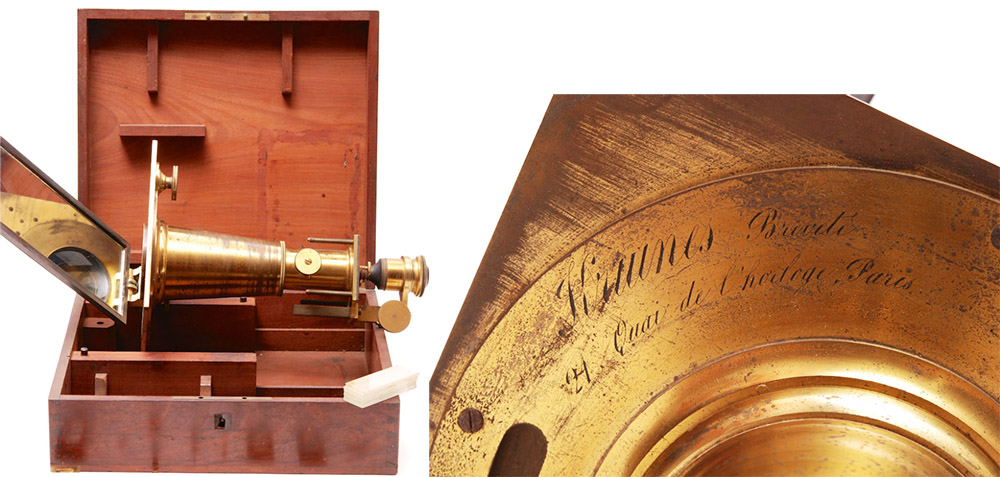
Figure 9.
A solar microscope, signed "Kruines, Brevete, 21 Quai de l'Horloge, Paris". That address indicates production after ca. 1850. Images adapted for nonprofit, educational purposes from an internet sale site.
Marie Francois Kruines was born on February 19, 1799 in Paris, son of Mathias and Marie-Madeleine Deffer Kruines. An older brother, Pierre Jean Francois Mathias Kruines, was born on October 9, 1796, suggesting that their parents were married during or before 1796. It is a reasonable guess that they were then in their early/mid-twenties, putting their likely birth dates ca. 1770.
I have not found any information on Mathias Kruines’ training. He first appeared in the Almanach du Commerce de Paris in the 1801 edition, which was published in late 1800, suggesting that the shop opened that year. The 1800 Almanach reports that a jeweler named Godard then occupied 42 Quai de l’Horloge, but Godard was gone the following year, further supporting the establishment of Kruines’ business in 1800.
As early as 1805, the Almanach reported that Mathias Kruines’ business emphasized manufacture of microscopes (Figure 10). The 1807 Almanach noted his production of “microscopes solaires, télescopes et instrumen de physique” (Figure 10).
An Medal of Honor was awarded at the 1806 Exposition des Produits de l'Industrie Française.
Kruines worked with a colleague named Lançon to develop a method for producion of a glass comparable to English flint glass. In 1808, they were awarded a prize from l'Académie des Sciences for inventing a product that was deemed superior to the English glass. Kruines and Lançon were evidently research collaborators, but not business partners, as a report stated that “M. Kruines, étant habile opticien, s'est servi de cette matière pour faire des lunettes achromatiques” (“Mr. Kruines, being a skilful optician, used this material to make achromatic glasses”).
Mathias Kruines died on March 26, 1811. Marie-Madeleine then took over the business (their sons were in their early teens). The 1812 Almanach listed the owner as “Kruynes (Ve.)” (sic), the abbreviation standing for “veuve” (widow).The Almanach for 1814 listed “Kruines (mad.)”, i.e. madam.
Marie-Madeleine Kruines earned a Medal of Honor at the 1819 Exposition des Produits de l'Industrie Française.
Marie-Madeleine was evidently alive, and operating the business, at the time that the 1827 Almanach was printed (Figure 10). On May 29 of the following year, son Marie-François-Antoine Kruines married Marie Amélíe Debar. By the end of 1828, ownership of the Kruines business had passed to Marie-François (Figure 10). It is likely that the wedding occurred around the time of the ownership transfer, with the relative financial stability of business ownership making marriage an affordable status. Records of the business refer to “M. Kruines”, and “he”, implying that Marie-François was the sole owner (if a brother had been involved, records would use “MM” to indicate multiple monsieurs). It is not known whether Marie-Madeleine died at that time, or simply retired - her death record has not yet been located.
A daughter, Marie-Clara Kruines, was born to Marie-François and Marie Amélíe on May 12, 1832. Two years later, an uncommon event occurred: Marie-François and Marie Amélíe were divorced. A legal record reads “Inventaire par suite de séparation de corps et de biens entre Marie François Kruinès, quai de l'Horloge, no 61 ter, et Marie Amélie Debar, son épouse, carrefour de l'Odéon, no 16. Filed 3 avril 1834” (“Inventory following separation of body and property between Marie François Kruinès, quai de l'Horloge, No. 61 ter, and Marie Amelie Debar, his wife, crossroads of the Odeon, No. 16. Filed 3 April 1834”).
A report of the 1834 Exposition des Produits de l'Industrie Française stated, “M. Kruines … est parvenu a faire un microscope qui permet d'observer dans toute leur vérité les infiniment petits qui existent dans là nature j non visibles à l'œil nu, soit en botanique, soit en minéralogie, soit en enthomologie, ainsi que tous les msectes qu'on trouve dans les eaux bourbeuses. Le prix trop élevé de ces instruments perfectionnés ne permettait pas jusqu'à présent aux personnes peu aisés de s'en procurer. Mais M. Kruines est parvenu a établir ces articles a très-bon marché; il a simplifié la monture et a conservé rigoureusement les soins voulus dans la partie de l'optique, qui est indispensable aux bons microscopes” (“M. Kruines … has managed to make a microscope which enables us to accurately observe the infinitely small which exist in nature, not visible to the naked eye, either in botany, mineralogy or entomology, as well as all the types found in muddy waters. The high price of these improved instruments did not allow so far the poor people to get them. But Mr. Kruines has succeeded in establishing these articles at a very cheap price; he has simplified the frame and has kept rigorous care in the part of optics, which is essential for good microscopes”).
The jury awarded him a Bronze Medal, stating, “M. Kruines expose des microscopes d'une construction particulière dont il est inventeur. Ces instruments ont le double mérite d’etre fort bien exécutés dans lenites de grossissement qu'il s est imposées, et d’étre li- és au commerce à des prix très-modiques” (“Mr. Kruines exhibits microscopes of a particular construction that he invented. These instruments have the double merit of being very well executed in terms of their magnification, and being sold at very moderate prices”).
In 1838, “M. Kruines (Marie-François-Antoine), opticien, demeurant à Paris, quai de l'Horloge, no. 61” was awarded a patent for a camera lucida, “propre à dessiner le paysage” (“suitable for drawing landscapes”).
Marie-François Kruines again won a Bronze Medal at the 1839 Exposition des Produits de l'Industrie Française, for his “microscopes d'un prix modéré, des chambres claires, des pantographes et quelques instruments de topographie” (“moderately priced microscopes, camera lucidas, pantographs and some surveying instruments”).
In 1843, a Pierre-Christian-Mathias Kruines died at 61 Quai de l’Horloge. He had the same name as one of Marie-François’s elder brothers. Although historical records imply that Marie-François was the sole owner of the Kruines business, there is an indication that one or more of his brothers may have been involved at some time: the Whipple Museum possesses a microscope that is signed "Kruines Freres". Pierre-Christian was only 45 years old when he died, so perhaps Marie-François took in his brother near the end of his life?
At the 1855 Exposition Universelle de France, “Kruines (M.-F.), à Paris, q. de l'Horloge, 21” exhibited “Niveau avec lunette pour mesurer les distances. Instruments de géodésie” (“level with magnifying scope to measure distances. Surveying instruments”). Note that the address of the business had changed to number 21 between 1843 and 1855.
The 1864 Almanach noted that 21 Quai de l’Horloge was occupied by four other businesses: an engraver named Levasseur, an officer “de paix” named Philippe, a paint brush maker named Vial, and a widow named Eulalie Zoé Lemonnier Rambaud who made “bourses”. There was a special relationship between Marie-François Kruines and Eulalie: on his death on April 20, 1866, Kruines named Eulalie executrix of his will. Eulalie and her son, Marius Désiré Rambaud, then took over the business, operating as “Kruines - Rambaud successor” and “Rambaud”. It is not known whether Kruines left the business to the Rambuds in his will, or if they purchased it from the estate. If the latter, as both executor of the will and buyer of the estate, Rambaud likely acquired the business for a very low price.
Marius Désiré Rambaud died January 2, 1873, whereupon his mother sold off the business. A legal record reads, “Inventaire après décès de Marius Désiré Rambaud dressé entre le 18 février et le 17 mars 1873, dans une maison 21, quai de l’Horloge, où le défunt est mort, le 2 janvier 1873, à la requête de sa mère, Eulalie Zoé Lemonnier, veuve de Claude Marius Rambaud, fabricante d’instruments d’optique, demeurant même adresse, et Auguste Léon Gennerat, architecte, demeurant 80, rue des Saints-Pères, tuteur légal de Madeleine Louise Augustine Rambaud, enfant naturel du défunt, (21 f.). - À signaler: Pierre Frédéric Lang et Sévère Honoré Boissel, tous deux opticiens 29 et 19 quai de l’Horloge, désignés en tant qu’experts, ont estimé, avec l’aide du commissaire-priseur, la valeur du fonds d’optique et de photographie à 256 francs et la valeur du matériel à 5 097,10 francs” (“Inventory after the death of Marius Désiré Rambaud enacted between February 18 and March 17, 1873, in a house 21, quai de l'Horloge, where the deceased died, January 2, 1873, at the request of his mother, Eulalie Zoé Lemonnier, widow of Claude Marius Rambaud, manufacturer of optical instruments, residing at the same address, and Auguste Léon Gennerat, architect, residing at 80, rue des Saints-Pères, legal guardian of Madeleine Louise Augustine Rambaud, natural child of the deceased, (21 f.). - Notable: Pierre Frédéric Lang and Sévère Honoré Boissel, both opticians 29 and 19 quai de l'Horloge, appointed as experts, estimated, with the help of the auctioneer, the value of the optical fund and photography at 256 francs and the value of the material at 5 097.10 francs”). In another conflict of interest, Sévère Boissel acquired the stock of the Rambaud business, and described his own shop as successor to Kruines and Rambaud (Figure 14).
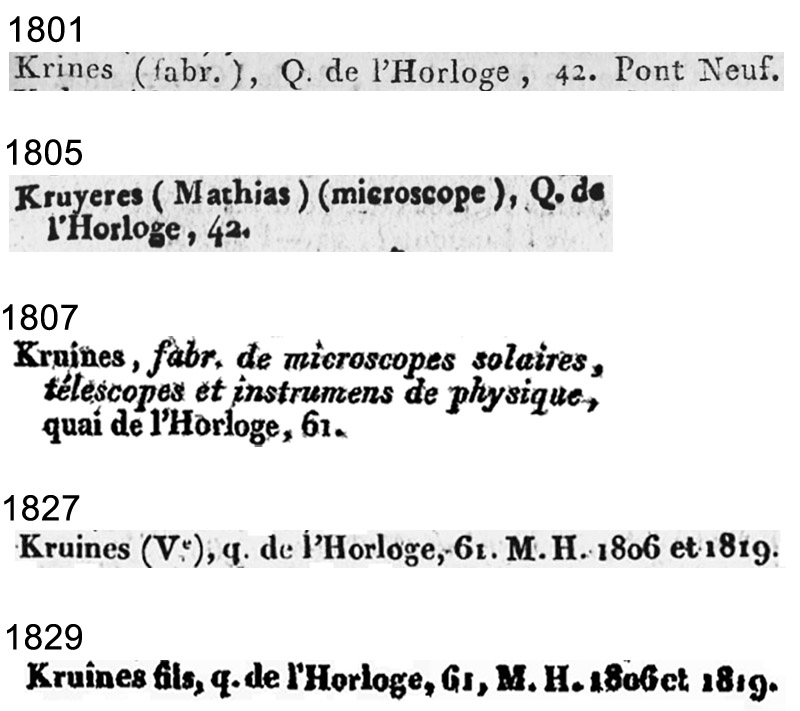
Figure 10.
Entries for Kruines businesses, from “Almanach du Commerce de Paris” (note that early editors had difficulty with spelling Kruines’ name). Mathais’ business first appeared in the 1801 edition of this business directory (published in late 1800), suggesting that he opened his shop during 1800. After Mathiass death in 1811, his widow, Marie-Madeleine operated the business through at least 1827 (the “Ve.” note after her surname means “Veuve”, i.e. “widow”). I have not located an 1828 edition of the “Almanach”, but the 1829 edition lists the owner as “Kruines fils” (“Kruines the son”, i.e. Marie-François-Antoine).

Figure 11.
An 1836 advertisement from “L'Echo du Monde Savant”.
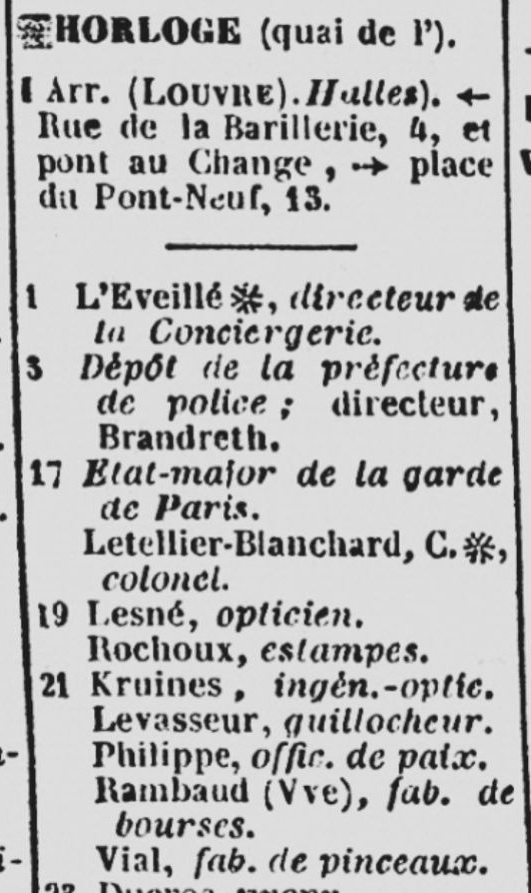
Figure 12.
Excerpt of businesses along Quai de l’Horloge in the 1864 “Almanach de Paris”. The widow Rambaud served as executrix of the will of Marie-François Kruines upon his death in 1866. She and her son, Marius Désiré Rambaud, then acquired the Kruines business, continuing it as “Kruines - Rambaud” / “Rambaud”.
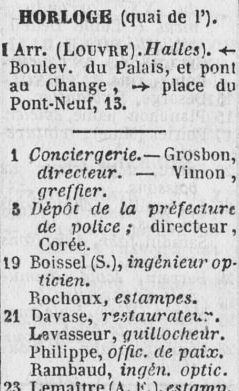
Figure 13.
Excerpt from the 1870 “Almanach de Paris”, listing the Rambauds as operators of Kruines’ old shop.
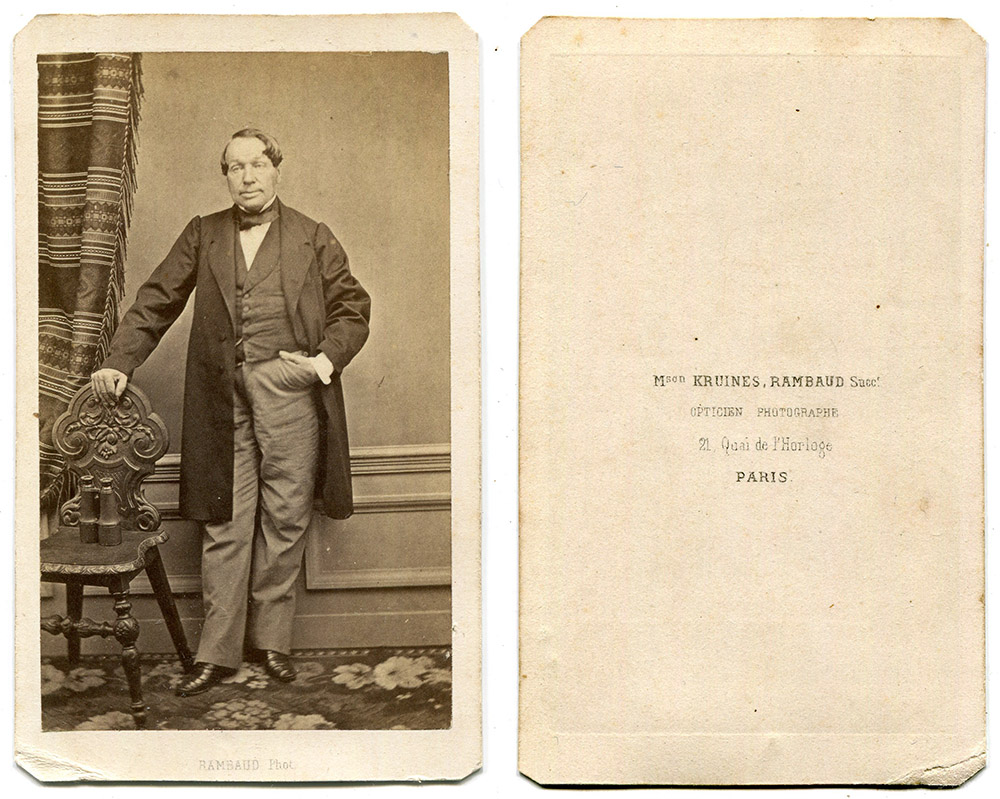
Figure 13B.
Circa 1870 carte-de-visite photograph, by "Maison Kruines, Rambaud Successor". Eulalie and Marius Rambaud acquired the Kruines business after Marie-François Kruines' death in 1866. Their stock was sold to Sévère Boissel after Marius' death in 1873, and sold from his previously-established shop at 19 Quai de l'Horloge.
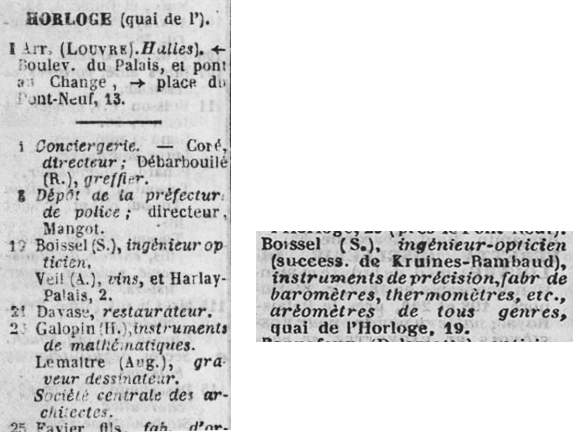
Figure 14.
Excerpts from the 1877 “Almanach”. A Mr. Galopin now had a mathematical instrument shop at 21 Quai de l’Horloge. However, the “Opticiens” section of the “Almanach” shows that Sévère Boissel, of 19 Quai de l’Horloge, claimed the title of successor to Kruines and Rambaud.
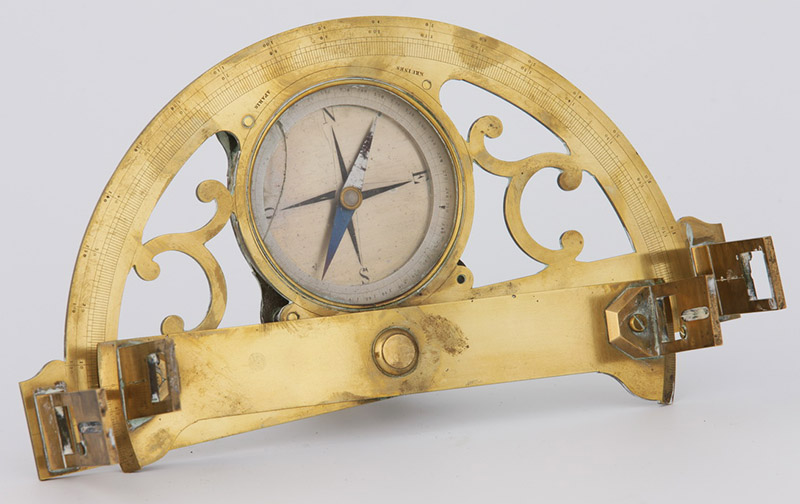
Figure 15.
A surveying instrument by Kruines. Adapted for nonprofit, educational purposes from an internet auction site.
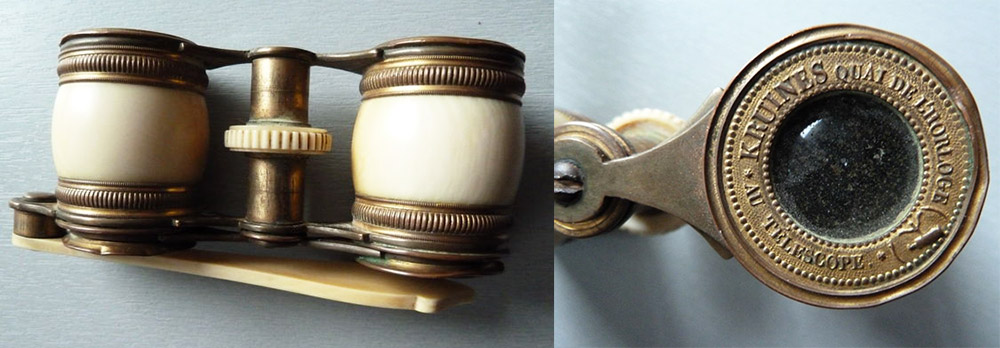
Figure 16.
Opera glasses that were made by Kruines. The shop sign was “The Telescope”. Adapted for nonprofit, educational purposes from an internet auction site.
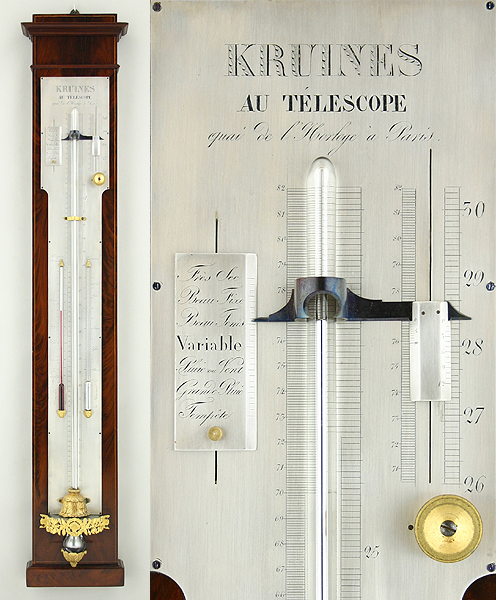
Figure 17.
A barometer by Kruines. The shop sign was “The Telescope”. Adapted for nonprofit, educational purposes from an internet auction site.
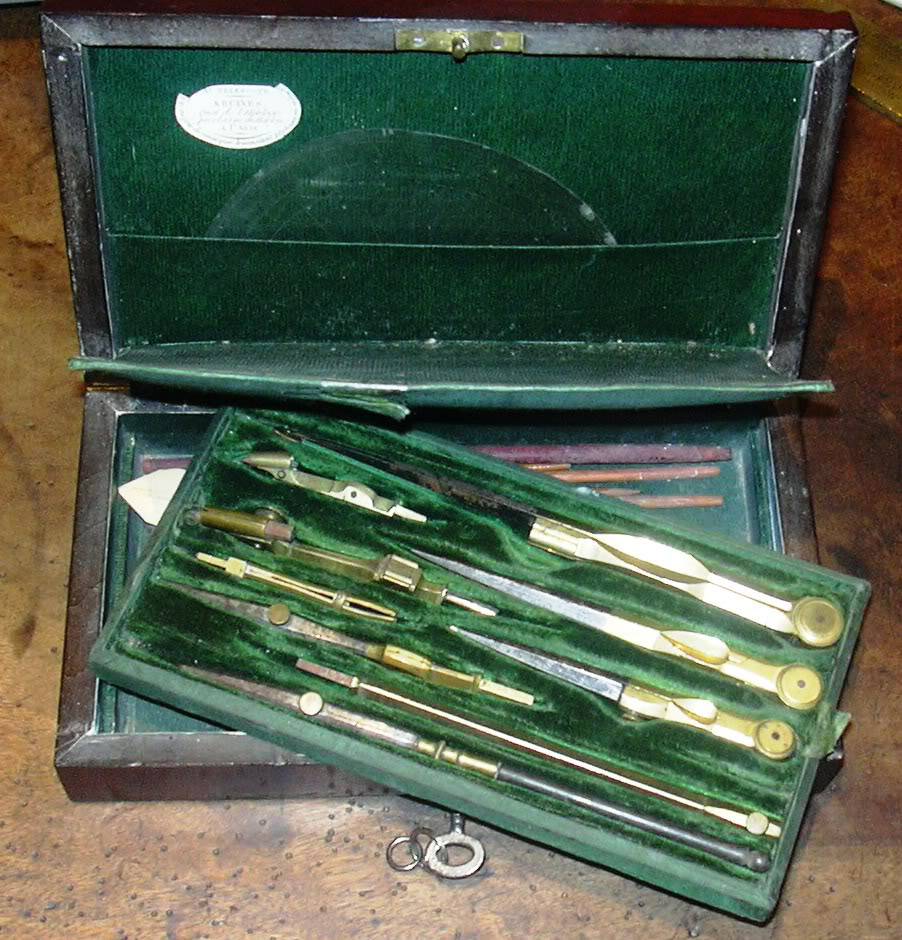
Figure 18.
A set of drafting tools with Kruines’s label pasted inside the lid. Adapted for nonprofit, educational purposes from an internet auction site.
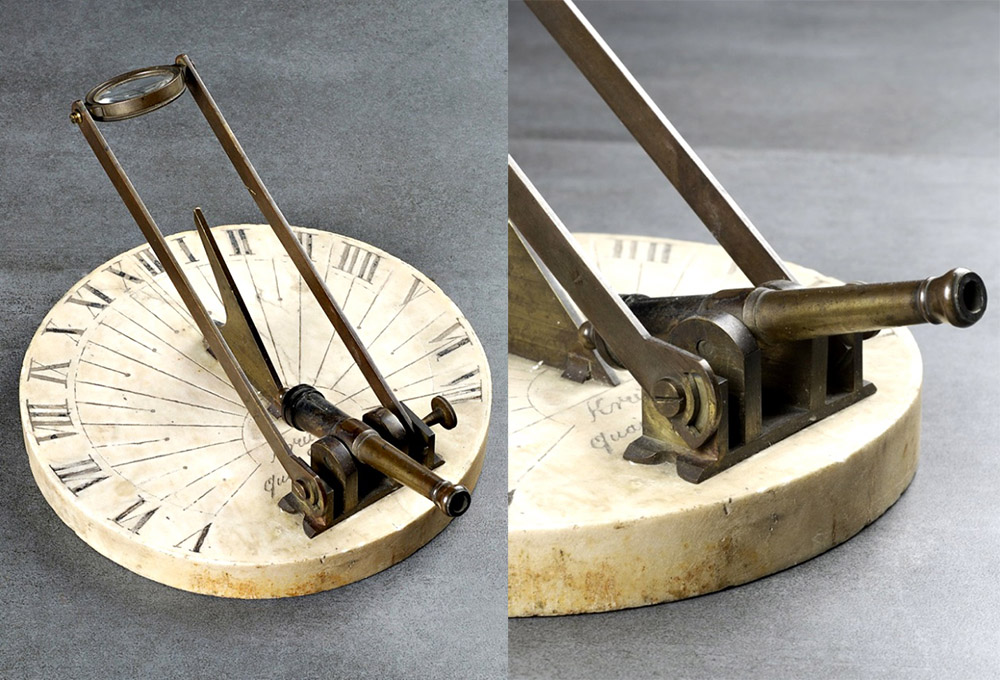
Figure 19.
A Kruines horological canon. the canon and magnifying glass can be oriented on the sundial so that focused light sets off the canon at a specified time. Adapted for nonprofit, educational purposes from https://watch-wiki.org/images/4/40/?C=N;O=D.
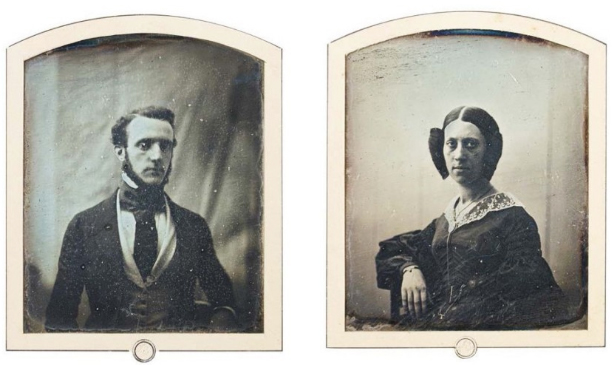
Figure 20.
Two quarter-plate daguerreotype photographs, each with Kruines’ label on the back. However, the fronts bear the seals of the well-known photographer Louis-Auguste Bisson (1814-1876). The relationship between Kruines and Bisson is not known. An attached manuscript reads, "A mon cher père, le 24 juin 1842, jour de la Saint-Jean, sa fête. Pauline de Obas Latrie”. Adapted for nonprofit, educational purposes from https://www.drouot.com/lot/publicShow/4705001.
Acknowledgement
Thank you to Joe Zeligs for insightful discussions, and for sharing images from his microscope database.
Resources
Almanach du Commerce de Paris (multiple years) accessed through https://gallica.bnf.fr
Birth record of Marie Clara Kruines (1832) accessed through ancestry.com
Birth record of Marie Francois Kruines (1799) accessed through ancestry.com
Birth record of Pierre Jean Francois Mathias Kruines (1796) accessed through ancestry.com
Catalogue Officiel Publié par Ordre de la Commission Impériale (1855) “Kruines (M.-F.), à Paris, q. de l'Horloge, 21. - Niveau avec lunette pour mesurer les distances. Instruments de géodésie”, page 46
Collection Nachet: Instruments Scientifiques et Livres Anciens (1929) George Petit, Paris, Plate XIII, and pages 34 and 36
Dictionnaire Chronologique et Raisonné des Descouvertes, Inventions, innovations, Perfectionnemens, Observations Nouvelles et Importations en France (1823) Flintglass economie industrielle, L. Colas, Paris, Vol 7, pages 181-182
Divorce record of of Marie François Kruinès and Marie Amélie Debar (1834) accessed through https://www.siv.archives-nationales.culture.gouv.fr
L'Echo du Monde Savant (1836) Advertisement from M.F. Kruines, page 76
Journal des Débats Politiques et Littéraires (1834) Exposition des Produits de l’Industrie, July 7 edition
Marriage record of Marie-François Kruines and Marie Amélíe Debar (1828) accessed through ancestry.com
Notice des Produits de l'Industrie Française (1834) M. Kruines, opticien, au Télescope, quai de l'Horloge du Palais, n. 61, près la rue du Harlay, Éverat, Paris, pages 153-154
Nowak, Hans Peter (1984) Geschichte des Mikroskops, Medizinhistorisches Institut der Universitat Zurich
Probate of the will of Marie-François Kruines (1866) “Dépôt judiciaire du testament de Marie François Kruines, fait à Paris le 20 décembre 1859, à la suite de son décès survenu en son domicile 24, quai de l'École, le 20 avril 1866. À signaler: le testataire institue Eulalie Lemonnier, veuve Rambaud, légataire universelle, et désigne son fils, Marius Rambaud, légataire de ses meubles”, accessed through https://www.siv.archives-nationales.culture.gouv.fr
Probate of the will of Marius Désiré Rambaud (1873) “Inventaire après décès de Marius Désiré Rambaud dressé entre le 18 février et le 17 mars 1873, dans une maison 21, quai de l’Horloge, où le défunt est mort, le 2 janvier 1873, à la requête de sa mère, Eulalie Zoé Lemonnier, veuve de Claude Marius Rambaud, fabricante d’instruments d’optique, demeurant même adresse, et Auguste Léon Gennerat, architecte, demeurant 80, rue des Saints-Pères, tuteur légal de Madeleine Louise Augustine Rambaud, enfant naturel du défunt, (21 f.). - À signaler : Pierre Frédéric Lang et Sévère Honoré Boissel, tous deux opticiens 29 et 19 quai de l’Horloge, désignés en tant qu’experts, ont estimé, avec l’aide du commissaire-priseur, la valeur du fonds d’optique et de photographie à 256 francs et la valeur du matériel à 5 097,10 francs”, accessed through https://www.siv.archives-nationales.culture.gouv.fr
Probate of the will of Mathias Kruines (1811) “Inventaire après décès: Kruines, Mathias. Horloge (quai de l'), no 61. Opticien”, accessed through https://www.siv.archives-nationales.culture.gouv.fr
Probate of the will of Pierre-Christian-Mathias Kruines (1873) “Inventaire après décès: Kruines, Pierre-Christian-Mathias. Horloge (quai de l'), no 61”, accessed through https://www.siv.archives-nationales.culture.gouv.fr
Rapport du Jury Central sur les Produits de l'Industrie Française Exposés (1834) pages 256-257




















